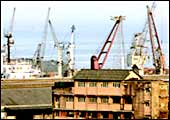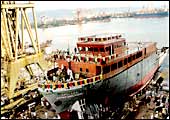 |
| L&T's Naik: Rooting for public-private
JVs |
In
the September of 2004, a member of the top brass of Larsen &
Toubro (L&T) shot off a letter to the shipping secretary,
proposing a joint venture with Hindustan Shipyard Ltd (HSL). HSL
is a sick public sector undertaking based in Visakhapatnam on
the east coast, one of just two shipyards in the country with
a capacity to build big ships (the other is Cochin Shipyard Ltd).
The proposed scheme envisages the formation of an associate company
of HSL, in which the engineering and construction giant would
pick up a majority stake, and into which HSL would transfer its
assets (minus its past liabilities) as its portion of equity.
L&T is particularly keen to foray into shipbuilding, keeping
in mind the global demand, three-fourths of which is currently
being met by South Korea, Japan and China. The way L&T sees
it, the government would continue to be the owner of HSL (as well
as of its past dues and liabilities), even as its infusion of
cash and utilisation of HSL assets via the joint venture would
go some way in initiating a turnaround at the loss-making PSU
(L&T is willing to pump in upwards of Rs 200 crore as equity
and for further investments).
The response, from the Joint Secretary, Shipping,
was quick, praising the company for its splendid idea. He requested
L&T to go ahead, to broadly outline the shape of the proposed
association and to communicate it to the Chairman & MD of
HSL. By early 2005, the L&T top brass was making a presentation
to the shipping secretary in his chambers, where were also present,
amongst others, representatives of the Ministry of Finance and
the Planning Commission. A decision was taken to value the worth
of HSL assets, as a step forward. The valuation took place by
March-April. What happened after that is unclear, but as things
stand today, the JV is as much a gleam in the eyes of A.M. Naik,
CMD, L&T, as it was 15 months ago.
 |
 |
AN EYE ON THE PUBLIC SECTOR
L&T sees huge potential for
partnerships with
state-owned units |
| PSU PROPOSAL |
| HINDUSTAN
SHIPYARD LTD: To form a 60:40 JV as an associate company
of HSL, with the majority being held by L&T, and the assets
of HSL transferred into the JV for building mega-size ships.
L&T would bring in cash, upwards of Rs 200 crore as its
contribution (including equity and investments)
MAZAGON DOCK LTD: To form
a JV with L&T holding a majority stake, which will jointly
implement the Scorpene submarine project (L&T will make
three and MDL three; currently, MDL has the mandate for
all six). The JV could go on to make indigenous submarines,
after the necessary technology absorption from Scorpene
HINDUSTAN AERONAUTICS: To
jointly implement-via a JV-the 30 per cent offset deals
that will accrue courtesy A-I and IA's orders for aircraft
from Boeing and Airbus. In the longer run, the JV could
go on to implement future offset deals that will arise in
the defence sector (on orders for field guns, tanks, avionics,
etc.)
NUCLEAR POWER CORP OF INDIA-BHEL:
For building turnkey nuclear power stations, L&T sees
a three-way JV between BHEL, NPCIL and L&T as an option,
with BHEL building the power island and L&T-NPCil the
nuclear island
|
| Note: Whilst the proposals
for HSL and Mazagon Dock have been made to the government,
those for HAL and NPCIL-BHEL-L&T haven't yet been |
Sitting in his office in C Block, at L&T's
sprawling works in Powai, deep in suburban Mumbai, Naik is still
hopeful the L&T-HSL venture will see the light of day. "For
decades the Indian shipbuilding industry has not been able to
exploit the international boom," says Naik. "HSL is
an ailing PSU but has the potential to become a successful shipbuilder
with suitable support. Since we are already into heavy fabrication,
shipbuilding is a good fit for us."
The L&T-HSL JV isn't the only proposal
Naik has in mind with the public sector. He's also keen to forge
such equity partnerships in the big-ticket areas of avionics,
nuclear power and defence. For instance, he wants to get a finger
in the lush pie of offset deals, via a JV with Hindustan Aeronautics
Ltd (HAL), another defence PSU. The 30 per cent offset deals on
the orders of planes from Boeing and Airbus to Air-India and Indian
Airlines-offsets broadly entail that components worth 30 per cent
of an overseas order's value will have to be supplied to the firm
executing the order- are estimated to be worth around Rs 7,000
crore over eight years. Defence experts point out that in the
years ahead, there will be offsets worth thousands of crores in
the defence sector, arising from orders for field guns, tanks,
fighter planes and the like. L&T feels a JV on the lines of
L&T-HAL would be best placed to be a programme manager, which
in turn will go about identifying vendors for individual components,
under ministerial supervision.
 |
| Whilst L&T is keen to jointly work with
MDL to develop submarines, the feeling within
MDL is that the PSU is quite capable of handling the job on
its own-and that a JV at this stage could well delay
the Scorpene submarine project further |
In the defence sector, too, Naik is keen to
forge a JV with Mazagon Dock Ltd (MDL), which he feels will eventually
help the Navy achieve its goal of owning indigenous submarines
by 2030. Based on the defence requirements of the Navy, the government
decided that six Scorpene submarines would be ordered via MDL.
L&T has proposed that the L&T-MDL joint venture could
facilitate the sharing of the order. The cost of the six-submarine
project was originally estimated at Rs 8,600 crore, but experts
say that time overruns-the first Scorpene submarine was supposed
to be commissioned by 2010, but will only be ready two years later-could
take the project cost up to Rs 12,000 crore. L&T is also keen
to forge a three-way partnership with Bharat Heavy Electricals
and the Nuclear Power Corporation of India Ltd (NPCIL) for building
turnkey nuclear power stations.
Such partnerships will doubtless lead to creation
of value for L&T shareholders-nuclear reactor fabrication,
for instance, is a high-margin business-but Naik prefers to underscore
a larger benefit of such associations. "I am a strong advocate
of public-private partnerships for making India powerful... L&T
is committed to the national endeavour... you must remember we
built India's first nuclear reactor," he says. Naik adds
that the entry of the private sector will hasten the process of
technology absorption and making India self-reliant-for instance,
in the Scorpene submarine deal, the government's goal is to first
build 12 submarines with varying degrees of help from Scorpene
and the next 12 should be totally indigenous, assuming MDL can
absorb the relevant technology and design capabilities. The country's
record at technology absorption in defence has been abysmal, with
technology transfer agreements proving a misnomer, and most PSUs
and the ordnance factories still resorting largely to the CKD/SKD
route of manufacture. That explains in a large part why 70 per
cent of the India's defence needs are met through imports.
 |
| Since the 60s, L&T has been partnering
with institutes like NPCIL in the area of nuclear
power, in space research with Isro and in defence with DRDO.
JVs with PSUs in these sectors could be one way to
take those partnerships forward |
The areas of defence, nuclear and aerospace
account for 10 per cent of L&T's revenues and operating margins,
at 15-20 per cent, are two times L&T's standalone margins
(according to Motilal Oswal Securities). Yet it's difficult to
be sceptical about Naik's nationalistic sentiments when you take
a glance at L&T's achievements in the areas of defence, nuclear
and aerospace. This is a company that fabricates rockets and satellites
for the missions of the Indian Space Research Organisation (ISRO).
It's the sole supplier of reactors for nuclear power plants and
is also a key player in development of core missile systems (like
Prithvi, Agni, Akash, Trishul and Nag) for the defence ministry.
With such credentials you would think L&T
is ideally placed to leverage the domain expertise of the PSU
universe along with its own expertise in engineering & design,
programme management, procurement and quality control, thereby
resulting in a win-win-win situation for all: The nation becomes
more self-reliant, public sector technology skills get upgraded
and L&T shareholders also benefit. Why then aren't the PSUs
playing ball? Consider L&T's proposal for a JV with HAL to
manage the forthcoming offset contracts of Boeing and Airbus.
Aviation sources point out that recent offsets have never been
fully honoured, with many of the agreements degenerating into
counter-trade and barter (instead of aircraft wings or seats,
or wiring harnesses being supplied, it's been usually commodities
like tea that are exported, and that too the entire value of the
offset is invariably never exploited). That's where L&T thinks
it can make a difference-by forming a programme management venture
with HAL, the JV can select the various vendors under the eagle
eye of a central ministerial monitoring committee, ensuring that
the full value of the offset deals is realised. "L&T
may not earn much, but what's important is that manufacturing
technology levels will rise across the entire aviation ancillary
industries," says Naik.
 |
| HAL Chairman Ashok Baweja: Not decided
yet |
| Sources at HAL confirm that several players
from the private sector-not just L&T-have approached it
for a partnership to handle the commercial
aviation offset deals. HAL has yet to decide whom to
partner, or whether to partner anyone at all |
From HAL's point of view, though, the moot
question is: Does it really need L&T? A spokesperson, on the
condition of anonymity, points out that several private sector
players have proposed JVs to handle the offset deals and "we
will decide whom to partner or whether we could execute on our
own". He counters that when IA bought two planes from Boeing
in 1994, HAL along with other players benefited from the offset
clause to the tune of Rs 95-110 crore, with HAL supplying components
like emergency auxiliary doors, undercarriage uplock boxes and
CAD/CAM software. HAL's upshot is that it has worked with Indian
private sector partners in the past-like Infosys, TCS, Satyam,
ITC Infotech and L&T- but exclusive partnerships might not
be the answer. For instance, when building the Sukhoi aircraft,
HAL outsourced 30 per cent of the work to various private sector
players.
 |
| Rear Admiral Ajit Tewari, Chairman &
Managing Director, HSL, agrees that strategic
partnerships with the private sector "might bring in
efficiencies and competencies to HSL". However,
he adds a crucial caveat: "Decisions on such partnerships
can only be taken by the government which is the owner of
the PSU'' |
L&T's view is that public-private partnerships
via contracts or build-operate-and-transfer agreements are all
fine, but the concept of a public-private joint venture-run with
the management and technical expertise of the private sector,
with funds from the private sector along with the PSUs' domain
expertise built over the past five decades-is long overdue. Naik
gives the example of the joint venture he's proposed with Mazagon
Dock. "We will bring our design and development skills to
the table and MDL has the capacity and the domain knowledge. Between
us, we have the resources to create an alternative Indian submarine
programme," says Naik. L&T's proposal is that an L&T-MDL
joint venture will help advance the commissioning date of the
first submarine from 2012 to 2010, which was as per the original
schedule. The hastening of the project could prove crucial because
the Navy is set to decommission its existing range, come 2010.
If MDL is able to deliver the first Scorpene sub only by 2012,
the Navy may have to hold on to the old lot or invest in leasing
fresh submarines.
Naik says roping in L&T will have two
benefits: One, the submarines will be delivered on schedule (but
only if he gets the order in the next three months), and two,
technological absorption will be faster, which will eventually
enable indigenous manufacture. Rear Admiral R.M. Bhatia, Chairman
& MD, MDL, isn't convinced: "It's a complex exercise
that involves foreign partners. As the contract has already been
awarded, creating a joint venture might (further) delay the project,"
says Bhatia, even as he doesn't rule out MDL's ability to absorb
design and development skills and eventually attempt to make submarines
indigenously.
 |
| The recent creation of ONGC Mittal Energy
is a classic public-private JV, which
will help address India's energy security problems. Will the
defence aerospace and nuclear sectors be the next arenas
for such alliances? |
Will MDL be able to meet the Navy's deadline
of 24 submarines (12 of them totally indigenous) by 2030, on its
own? That's not an easy question to answer. If tentative optimism
does exist in some quarters within MDL, it's because MDL isn't
a sick company. HSL, on the other hand, though, is a stretcher
case and badly in need of a healing touch. Today shipbuilding
accounts for just around a third of its business, with the rest
coming from ship repair. Accumulated losses and a negative net
worth have prompted the shipping ministry to work on a restructuring
package for HSL (which is still awaiting approval). But Rear Admiral
Ajit Tewari, Chairman & Managing Director, HSL, agrees that
"a strategic partnership with the private sector might help
bring in efficiencies and competencies to HSL". But he also
talks about "a public-public partnership which can be useful
for bringing in new technologies and investments". The problem
for HSL, though, is not a choice between a public-public or a
private partnership; it lies elsewhere. As Tewari explains: "Decisions
on such partnerships can only be taken by the government, which
is the owner of the PSU.''
 |
| If L&T is able to move ahead with its
public-private partnership model, the
concept of "co-investment" may work out as
a feasible alternative to disinvestment, at least in the shorter
run |
That could well be the nub of the problem-the
reluctance of either the government
or the PSU to take a decision on partnering with the private sector.
The problem could also be historic, what with the public sector
staunchly resisting the entry of private players into areas it
considered its fiefdom in the seventies and eighties. Perhaps
that monopolistic mindset still prevails, although the flip side
is that there are few Indian companies in the private sector that
have the technological depth to be able to address the country's
defence, nuclear and aerospace needs. Contrary to popular perception,
the public sector is not all dross--of the 250-odd central PSUs,
a third are loss-making. The government on its part has proposed
a policy to grant autonomy to navratnas and mini-ratnas for acquisitions
and joint ventures. Another silver lining is the creation of ONGC
Mittal Energy Ltd (OMEL), a JV between the Indian oil giant and
Lakshmi Mittal, which recently acquired oil blocks in Nigeria.
Such JVs will help address the crucial energy security problem.
Like ONGC, there are other immensely viable PSUs operating in
crucial sectors that could benefit from private sector associations-BEML,
BEL, Coal India, Cochin Refineries, Hudco, NHPC, NMDC, NTPC, NJPC,
NPCIL...the list is long, and you can be fairly sure it's not
just L&T that will relish the opportunity to unleash the value
locked in such PSUs.
-additional reporting by
Venkatesha Babu and E. Kumar Sharma
|












